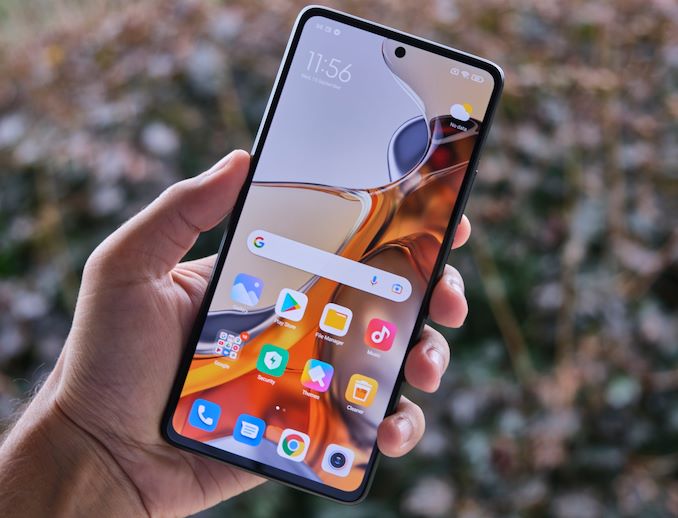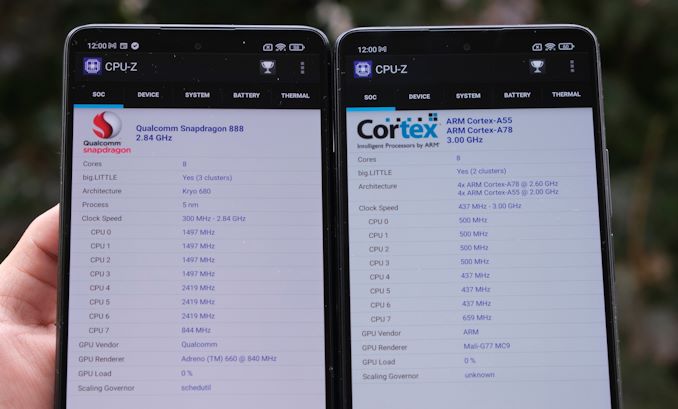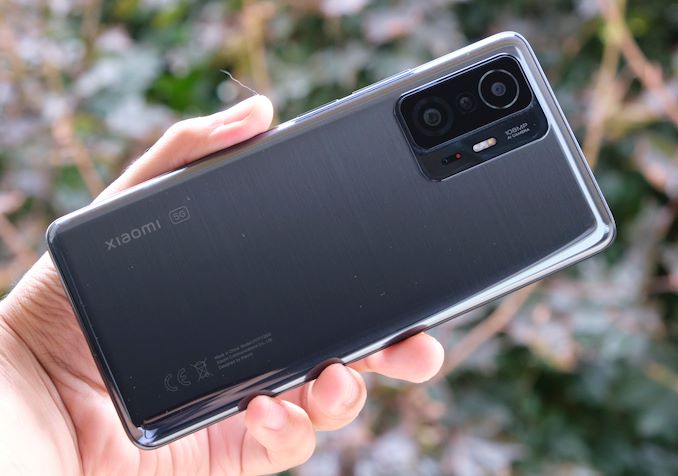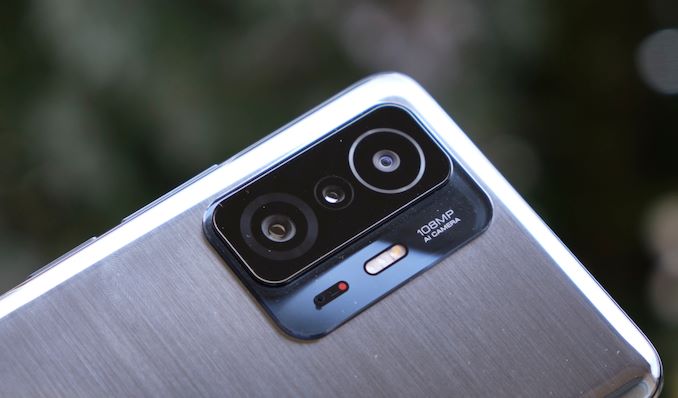The Xiaomi 11T & 11T Pro Review: Two Chips, With a Battery Focus
by Andrei Frumusanu on September 15, 2021 9:00 AM EST- Posted in
- Mobile
- Smartphones
- Xiaomi
- Xiaomi 11T
- Xiaomi 11T Pro

Today Xiaomi is announcing three new devices – the 11T, the 11T Pro and the 11 Lite 5G NE. We’ve had the first two in for review for a bit now and are able to give some first-hand experiences with the phones today.
The Xiaomi 11T series – which by the way isn’t called anymore “Mi” in the name, it’s literally just “Xiaomi 11T” now, are supposed to be additions to the company’s flagship line-up, but coming in at lower price points. We had reviewed the Mi 11 back in March and the big brother, the Mi 11 Ultra in July, so make sure to read those pieces as the 11T series fits into the line-up, albeit being different.
What defines the 11T series is the fact that they’re slightly lower priced and more budget than the original Mi 11, notably on the display side which has now been reduced to a 1080p panel. Build quality is also different, and finally, we’re seeing a different set of SoC options depending on whether you get the regular 11T or the higher-end 11T Pro.
| Xiaomi 11T Series | |||
| 11T | 11T Pro | ||
| SoC | MediaTek Dimensity 1200 1x Cortex-A78 @ 3.00GHz 3x Cortex-A78 @ 2.60GHz 4x Cortex-A55 @ 2.00GHz Mali-G77MP9 |
Qualcomm Snapdragon 888 1x Cortex-X1 @ 2.84GHz 3x Cortex-A78 @ 2.42GHz 4x Cortex-A55 @ 1.80GHz Adreno 660 @ 840MHz |
|
| DRAM | 8GB LPDDR5-6400 | 8/12GB LPDDR5-6400 | |
| Display | 6.67" AMOLED 2400 x 1080 120Hz Refresh 480Hz Touch HDR10+ / 10-bit panel |
||
| Size | Height | 164.1mm | |
| Width | 76.9mm | ||
| Depth | 8.8mm | ||
| Weight | 203g | 204g | |
| Battery Capacity | 5000mAh (Typical) 67W Charging |
5000mAh (Typical) 120W Charging |
|
| Wireless Charging | - | - | |
| Rear Cameras | |||
| Main | 108MP HM2 1/1.3" 0.7µm 9:1 Binning to 12MP / 1.4µm f/1.75 24mm eq. |
||
| Telephoto | 5MP (Macro only) f/2.4 48mm eq. |
||
| Extra Telephoto |
- | ||
| Ultra-Wide | 8MP f/2.2 120° FoV |
||
| Extra | - | ||
| Front Camera | 16MP f/2.45 |
||
| Storage | 128/256GB | ||
| I/O | USB-C | ||
| Wireless (local) | 802.11 (Wifi 6), Bluetooth 5.2 |
||
| Cellular | 4G + 5G NR NSA+SA Sub-6GHz | ||
| Special Features | Capacitive side fingerprint sensor (power button) Full-range stereo speakers IR Blaster |
||
| Splash, Water, Dust Resistance | No rating | ||
| Dual-SIM | 2x nano-SIM | ||
| Launch OS | Android 11 w/ MIUI | Android 11 w/ MIUI | |
| Launch Price | 8+128GB: 499€ 8+256GB: 549€ |
8+128GB: 649€ 8+256GB: 699€ 12+256GB: 749€ |
|
Starting off with the SoCs, the two 11T devices are absolutely interesting phones as besides the usual Samsung Galaxy devices each year who are powered by Snapdragon and Exynos SoCs, Xiaomi is employing a similar strategy here with the 11T series in dual-sourcing both from Qualcomm and from MediaTek.
The regular 11T is powered by the MediaTek Dimensity 1200 “Ultra” – we’re not sure what the Ultra here stands for but it seems it’s related to a high clocked NPU – there are no differences on the CPU clocks. The SoC features a Cortex-A78 at up to 3.00GHz, three A78’s at 2.60GHz, and four A55’s at 2.00GHz. The GPU is a MaliG77MP9, although we can’t confirm the frequency. This is MediaTek’s highest end chip at this moment in time, so it’s quite interesting. What also makes it special is that it’s on TSMC’s 6nm process node, and it’s the first chip we’ve had in our hands on this node.
The Snapdragon 888 needs no introduction, and that’s what’s powering the 11T Pro. There are a few oddities with the chip though, which we’ll cover in the system performance section, but the way Xiaomi is configuring the chip isn’t quite flagship level in terms of behaviour.
What’s very exciting about the two devices with differing SoCs is that both phones are otherwise absolutely identical in specifications. It’s essentially the same phone, just with a different SoC, and different charging capabilities. For apples-to-apples chipset comparisons, it rarely gets better than this, though we’ll see that there are behavioural discrepancies.
The back of the phone is relatively generic with its glass back. One thing to note here is that the phone is a bit more on the wider side at 76.9mm. Weight is reasonable at 203-204g due to the 5000mAh battery.
In general, the build quality and design of the phone isn’t quite as attractive and sleek as what we saw on the Mi 11, and it does feel like a slightly cheaper / lower end model in the Mi 11 flagship series.
On the camera side of things, Xiaomi is employing a 108MP sensor, but this is not the HMX that was found in the Mi 11 but rather the smaller HM2 sensor which uses 0.7µm pixels compared to 0.8µm on the sibling. The optics are 24mm equivalent focal length at f/1.75 aperture, but without OIS.
There’s a 5MP telephoto module but this is only used for macro shots, it can’t be used for any actual zooming in.
Finally, there’s a basic 8MP ultra-wide with f/2.2 and 120° field of view – it’s really basic. In general, the whole camera setup is simple and Xiaomi doesn’t give it too great specifications.
Xiaomi is focusing around fast-charging in these devices, notably the 11T Pro comes with a 120W charger. It performs as advertised; however, we’ll be talking about the topic in more depth in the review.
The 11T starts at 499€, which is quite reasonable, and the 11T Pro starts at 649€ - which is actually quite steep given that one can have the Mi 11 for around 715€ nowadays, the phone would have to somehow rationalise itself in its differentiations compared to its series sibling.














41 Comments
View All Comments
arayoflight - Wednesday, September 15, 2021 - link
The battery life test of D1200 phone is rather surprising. The OnePlus Nord 2 which uses the same chipset does pretty well in GSMArena's battery test: https://fdn.gsmarena.com/imgroot/reviews/21/oneplu...yeeeeman - Wednesday, September 15, 2021 - link
Yep, I suspect this is a xiaomi thing, not something really bad with the soc, as I would expect mediatek engineer to be able to test power consumption of their soc before releasing it to the market.flipp0 - Thursday, September 16, 2021 - link
Yes, I had the Nord 2 and battery life was great. I think it is likley that anandtech got a faulty 11T unit or that 11T has some kind of software bug draining the battery. I am suprised that Andrei does not mention this a possible explanation for the results reported in this review.Spunjji - Monday, September 20, 2021 - link
Crappy software. Glad to see they fixed it, but that was pretty poor to be releasing a review unit in such a bad state.eastcoast_pete - Wednesday, September 15, 2021 - link
Thanks for the test, especially taking a close look at power management of the SoCs! I guess the overheating issue with the 888 indicates both the appetite of the X1 for power, and the need for good thermal design when used in a close, confined space like a Smartphone. Almost looks as if Xiaomi assumed that designs for older, lower powered SoCs would work just fine with the 888, and was in for a nasty surprise when it didn't.It's too bad that Xiaomi seems to then insist on "improving" these phones with their idea of enhancement by software, which clearly doesn't work. Those results for the Dimensity are also surprising, and not in a good way.
The temperatures measured remind me of an old phone with the SD 808 many years ago; probably the worst SoC QC I ever had the displeasure of owning.
shabby - Wednesday, September 15, 2021 - link
Interesting to see the price difference when the only difference is the soc, Qualcomm sure charges a premium.shabby - Wednesday, September 15, 2021 - link
But ouch that battery life, shirley some software updates might fix this?Spunjji - Monday, September 20, 2021 - link
And they did!PEJUman - Wednesday, September 15, 2021 - link
Curious if Xiaomi is using 'power' cells instead of 'energy' cells on their phones. Or if they are simply pushing energy cells with obscene C rates (at 4V * 4Ah, that's a mere 16 Wh of energy capacity), charging this at 100+ Watts to full is basically 6+ C charging rates.Either they have great battery tech, not sure who is their supplier for these... or the customer will just have to contend with rapid aging of their battery as they fast charge it everyday.
DanNeely - Wednesday, September 15, 2021 - link
Killing batteries early goes right with making battery replacement difficult as a means to drive more sales of new phones.